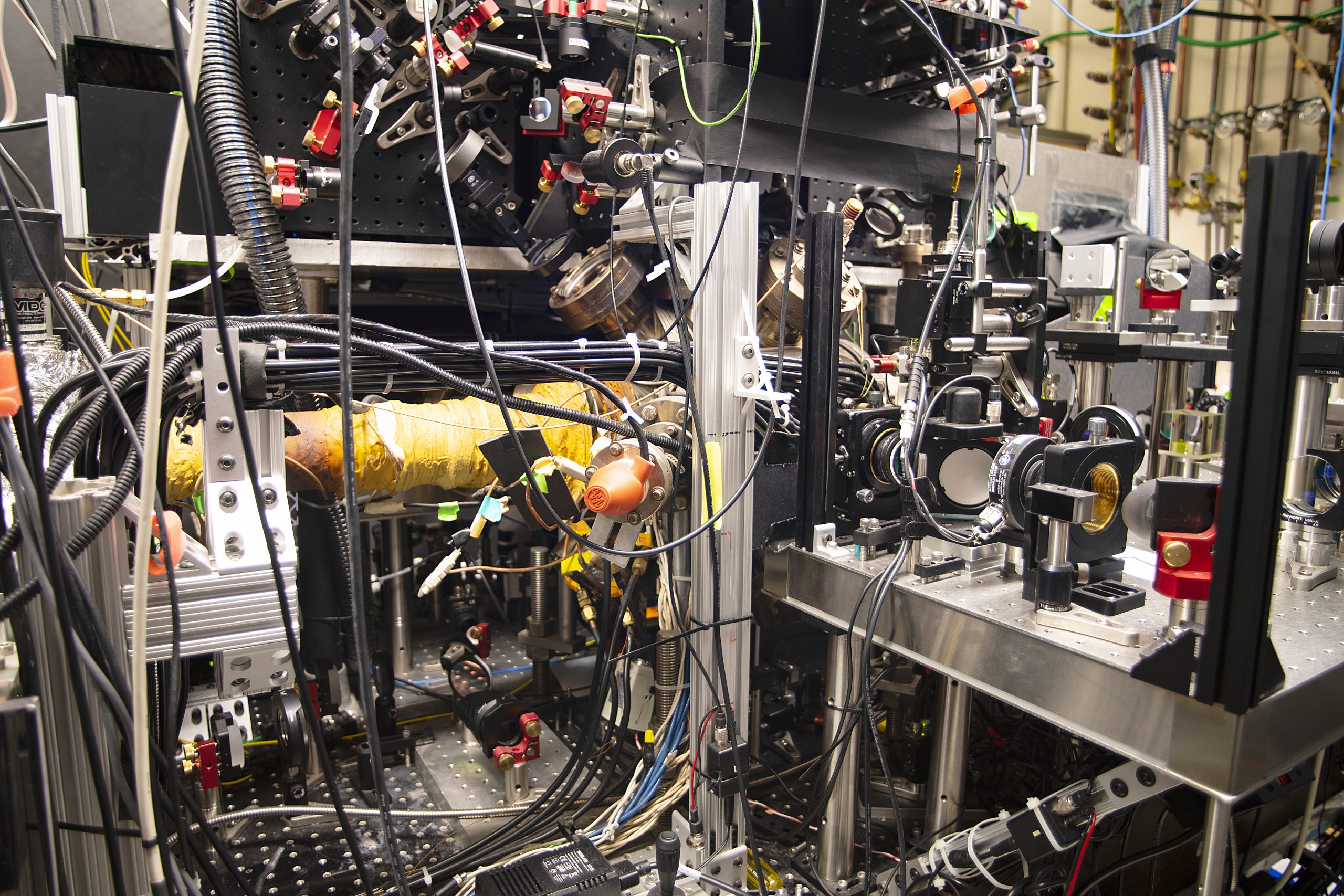BEC 1 — Lithium Lab – (closed)
Background: The Sodium-Lithium Double-Species Experiment
gases (see also PhD theses of Subhadeep Gupta (pdf) and Zoran Hadzibabic (pdf)). The machine is the
same that produced the first sodium Bose-Einstein condensates (BECs) in 1995. In 2001, the machine
was upgraded to a double-species machine by adding fermionic lithium-6 atoms (PhD thesis and
review paper by Claudiu Stan) and a new laser system for laser-cooling of lithium (undergraduate
thesis: Martin Zwierlein (pdf)). Using sodium as the “refrigerant”, spin-polarized fermionic lithium is
cooled to degenerate temperatures in a magnetic trap. One can now choose to either leave sodium
in the trap and study this Bose-Fermi mixture, or one can focus on fermions by evaporating all the
sodium away. Typically, all further experiments take place in an optical dipole trap, which can hold
atoms regardless of their spin-orientation. By applying high magnetic fields, it is then possible to access
regimes of strong interactions in Bose-Fermi mixtures or spin mixtures of fermions close to so-called
Feshbach resonances
Feshbach Resonances and the BEC-BCS crossover
Feshbach resonances are a unique tool for atomic physics. By the simple change of a magnetic field
the interactions between atoms can be controlled over an enormous range. This tunability arises
from the coupling of free unbound atoms to a molecular state in which the atoms are tightly bound.
The closer this molecular level lies with respect to the energy of two free atoms, the stronger the
interaction between them. In the example on the left, the two free atoms are both “spin up”, where
as the molecular state is a “singlet”, in which the atoms have opposite spin, adding up to zero total
magnetic moment. Thus, a magnetic field shifts the energies of two free atoms relative to the molecular
state and thereby controls the interatomic interaction strength.
From BEC to BCS
The interaction between two atoms can be described by the scattering length, shown on the right
versus magnetic field close to a Feshbach resonance. On the side where the scattering length is positive,
the molecular energy level is lower in energy than the energy of two unbound atoms. The molecular state
is thus “real” and stable, and atoms tend to form molecules. If those atoms are fermions, the resulting
molecule is a boson. A gas of these molecules can thus undergo Bose-Einstein condensation (BEC).
This side of the resonance is therefore called “BEC-side”. On the side of the resonance where the scattering
length is negative, isolated molecules are unstable. Nevertheless, when surrounded by the medium of
others, two fermions can still form a loosely bound pair, whose size can become comparable to or even
larger than the average distance between particles. A Bose-Einstein condensate of these fragile pairs is
called a “BCS-state”, after Bardeen, Cooper and Schrieffer. This is what occurs in superconductors, in
which current flows without resistance thanks to a condensate of electron pairs (“Cooper pairs”).

Background: The Sodium-Lithium Double-Species Experiment
gases (see also PhD theses of Subhadeep Gupta (pdf) and Zoran Hadzibabic (pdf)). The machine is the
same that produced the first sodium Bose-Einstein condensates (BECs) in 1995. In 2001, the machine
was upgraded to a double-species machine by adding fermionic lithium-6 atoms (PhD thesis and
review paper by Claudiu Stan) and a new laser system for laser-cooling of lithium (undergraduate
thesis: Martin Zwierlein (pdf)). Using sodium as the “refrigerant”, spin-polarized fermionic lithium is
cooled to degenerate temperatures in a magnetic trap. One can now choose to either leave sodium
in the trap and study this Bose-Fermi mixture, or one can focus on fermions by evaporating all the
sodium away. Typically, all further experiments take place in an optical dipole trap, which can hold
atoms regardless of their spin-orientation. By applying high magnetic fields, it is then possible to access
regimes of strong interactions in Bose-Fermi mixtures or spin mixtures of fermions close to so-called
Feshbach resonances
The universal regime
Directly on resonance, the molecular energy is equal to that of two free atoms. The scattering length
diverges and does not play any role anymore in the description of the gas. Physics is said to be “universal”
in this regime, where the only length scale of importance is the average distance between particles.
It uniquely determines the energy content of the gas, its pressure and all other properties. Here, the size
of fermion pairs must necessarily be comparable to the interparticle distance. Condensation of these pairs
will occur and the gas will be a superfluid at low enough temperatures.
An ideal model system
We see that with the simple change of a magnetic field close to a Feshbach resonance, a Fermi gas
of atoms can be brought into very different regimes of pairing. From a Bose-Einstein condensate of
tightly bound molecules on the BEC-side, through the universal regime on resonance and to a BCS
superfluid of long-range pairs. Fermi gases thus provide the ideal testbed to study strongly interacting
systems which occur in vastly different areas of physics, from superfluid Helium-3 to High-T_C
superconductors, from the quark-gluon plasma of the early Universe to neutron stars.
